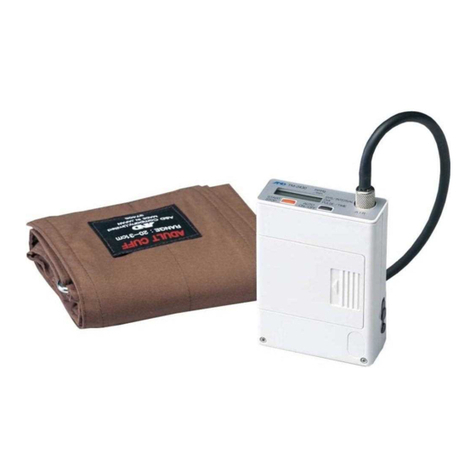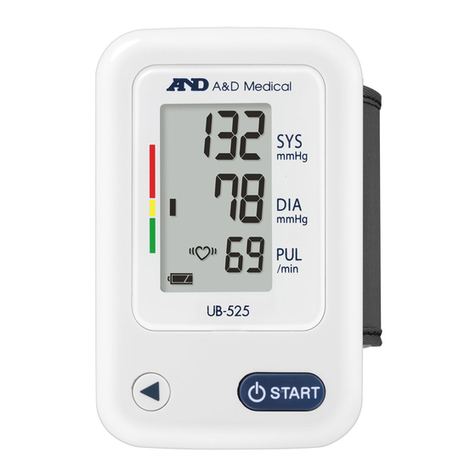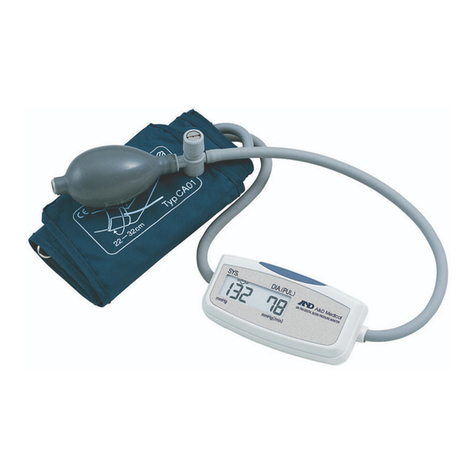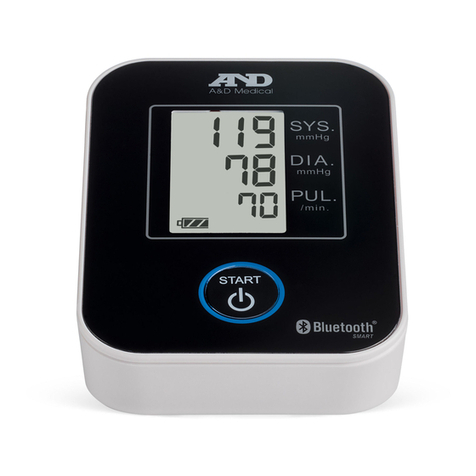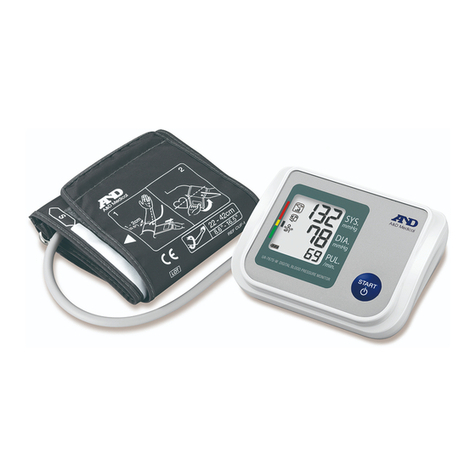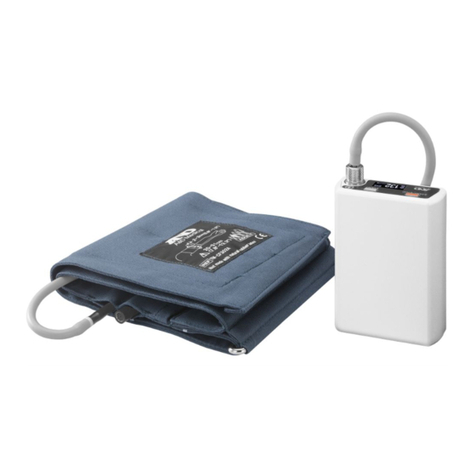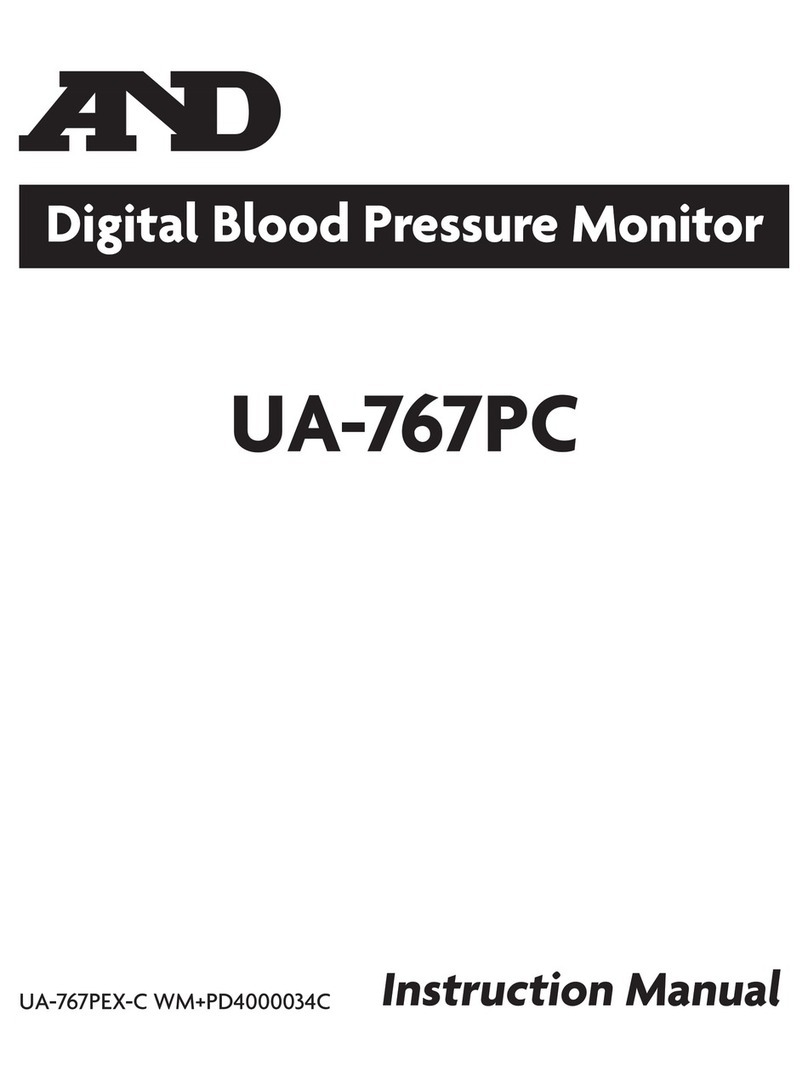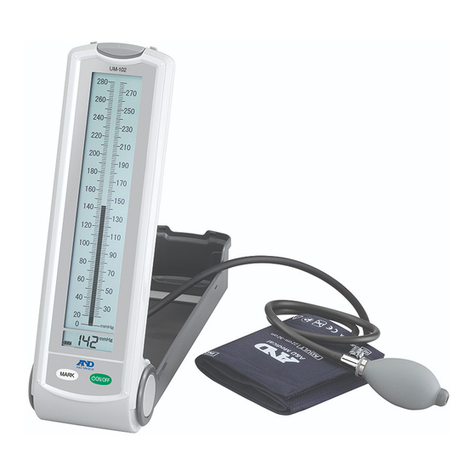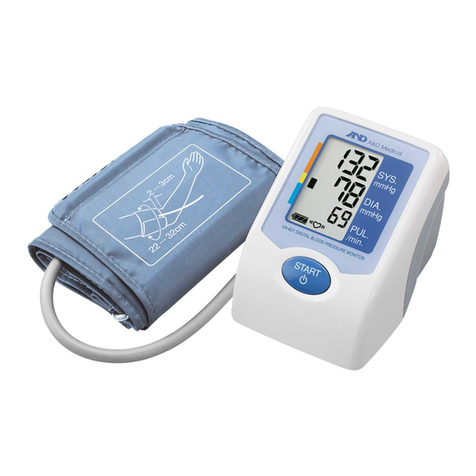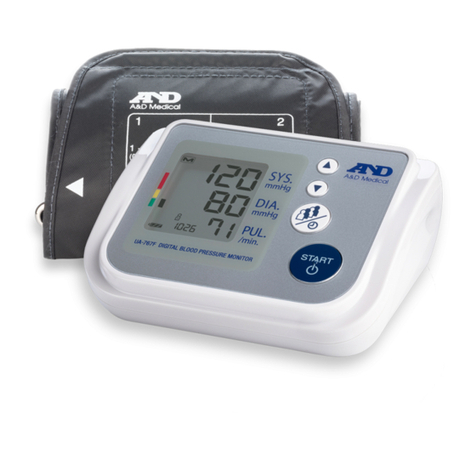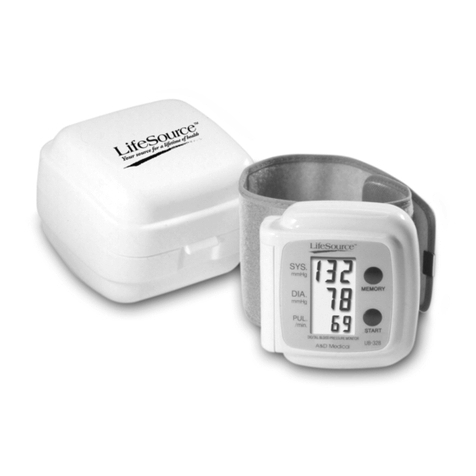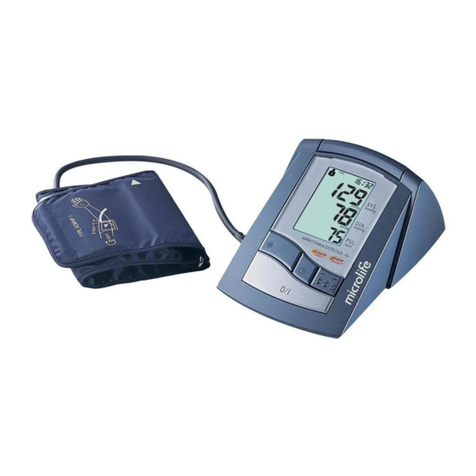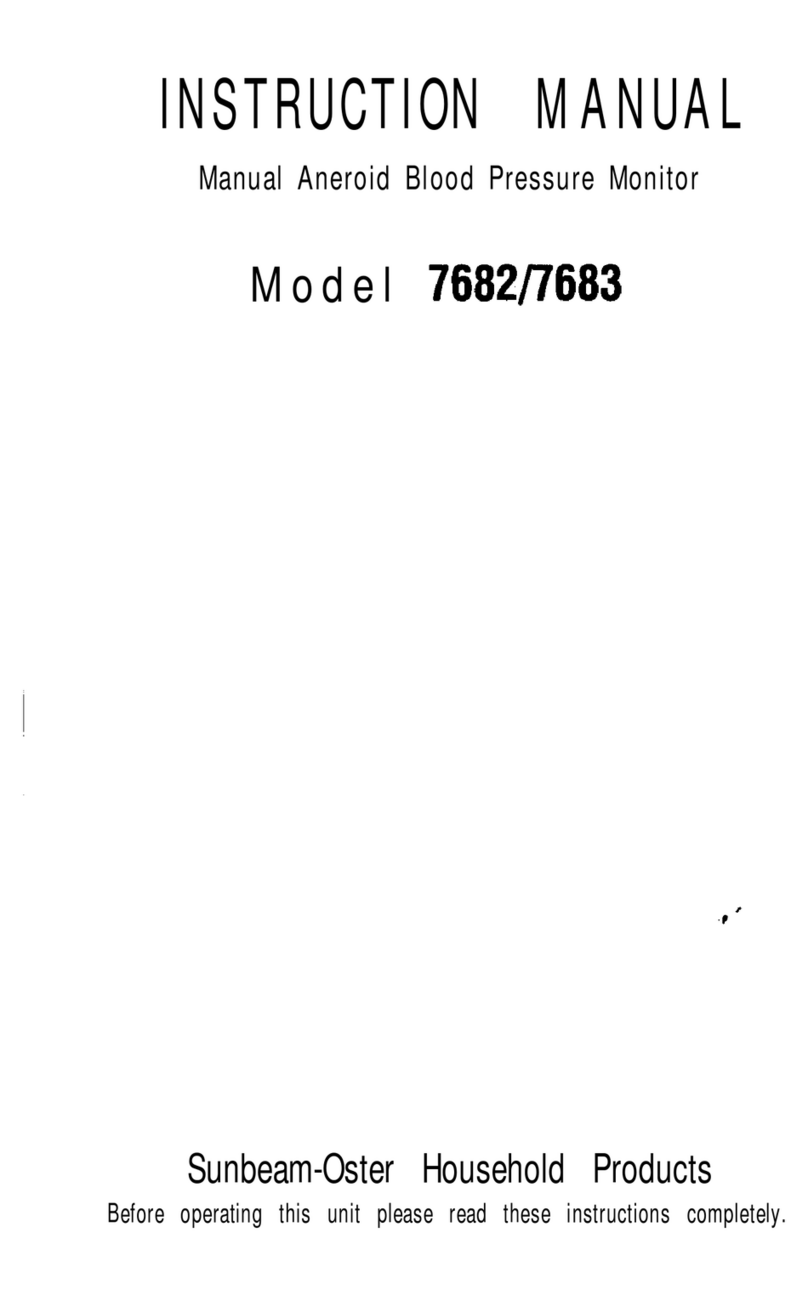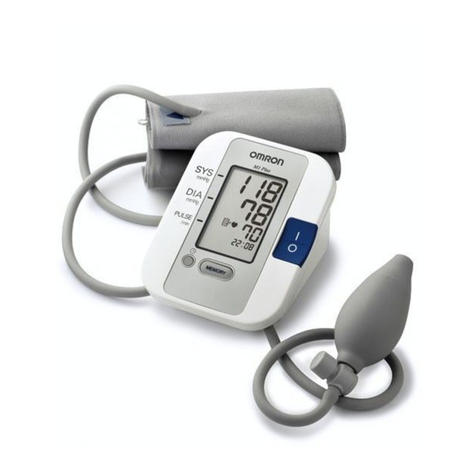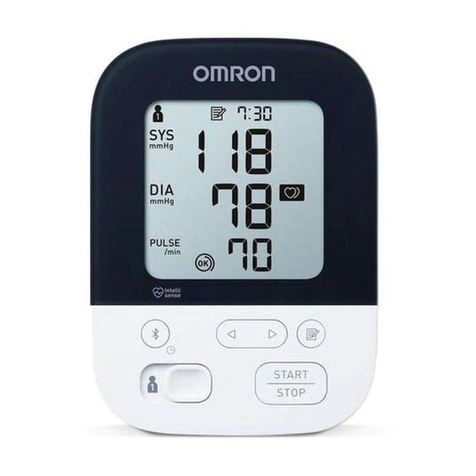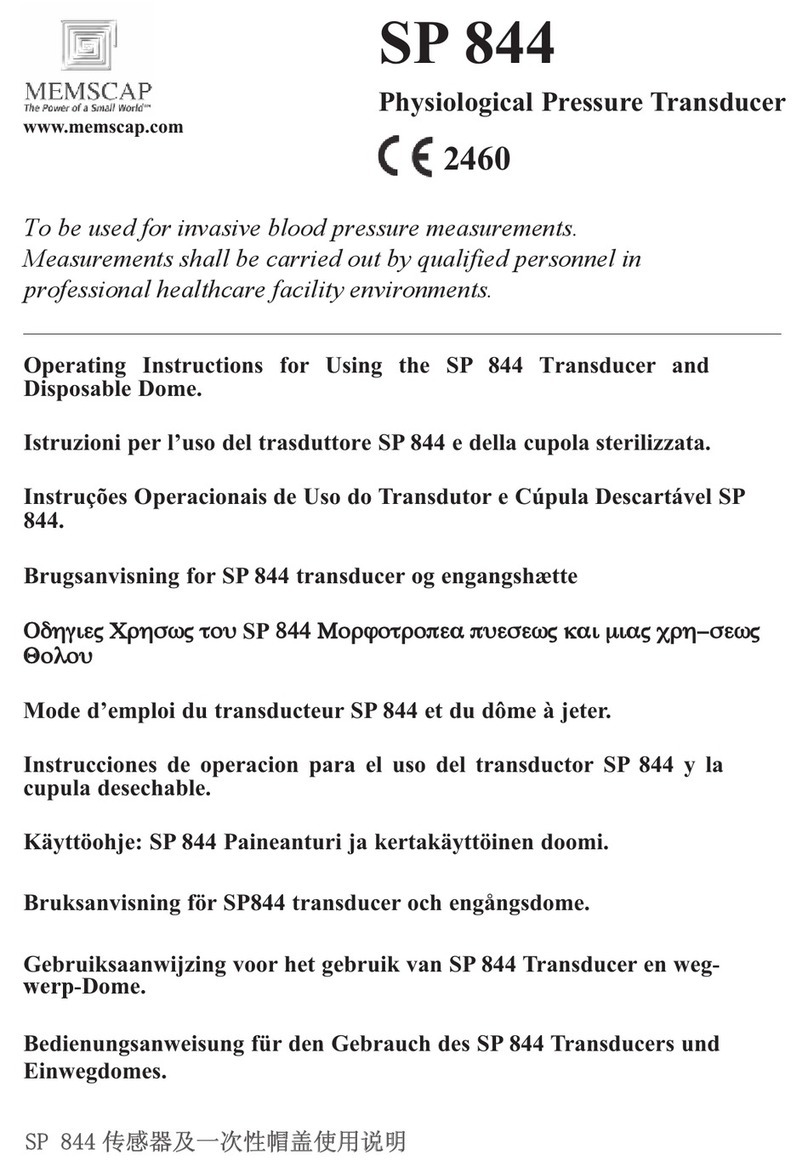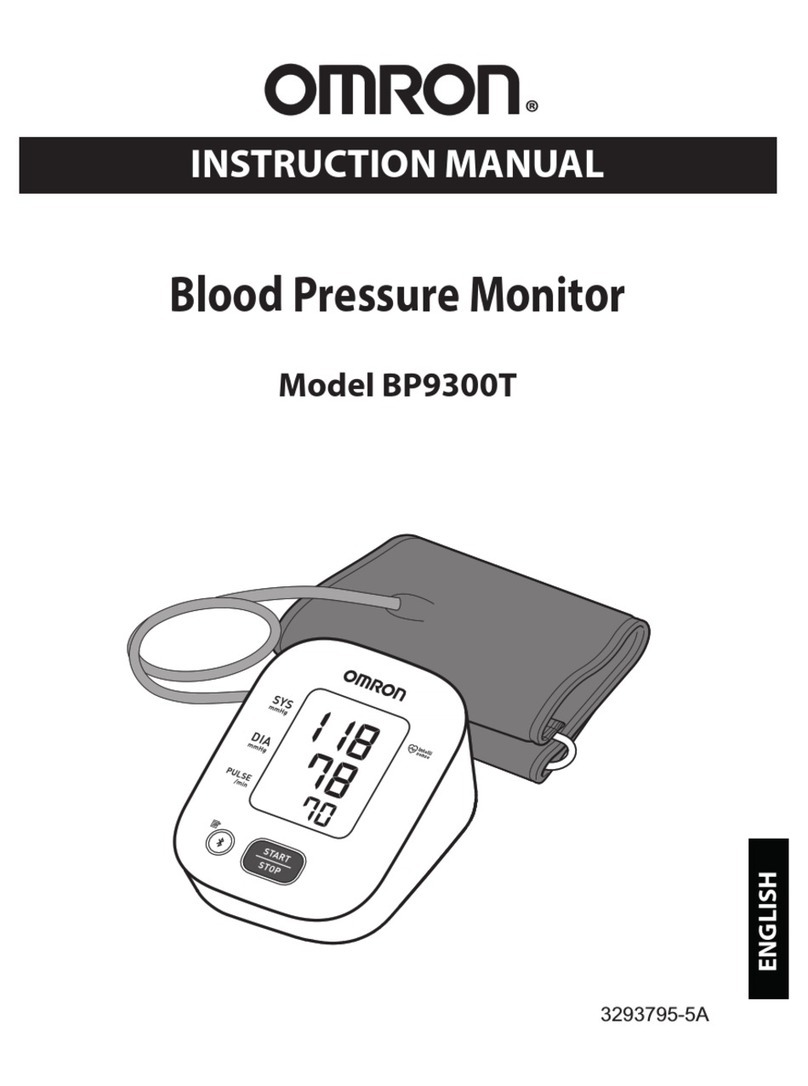AND UA-1010 User manual

Digital Blood Pressure Monitor
Model UA-1010
Instruction Manual
Original
Manuel d
instructions
Manual de Instrucciones
Manuale di Istruzioni
↪ᚻౠ
1WMPD4002223A

13

English 1
Contents
Dear Customers.................................................................... 2
Preliminary Remarks ............................................................. 2
Precautions........................................................................... 2
Parts Identification................................................................ 3
Symbols................................................................................ 4
Operation Mode.................................................................... 6
Using the Monitor ................................................................. 7
Installing / Changing the Batteries ................................... 7
Connecting the Air Hose .................................................. 7
Connecting the AC Adapter.............................................. 7
Adjusting the Built-in Clock ............................................. 8
Selecting the Correct Cuff Size ......................................... 9
Applying the Arm Cuff ..................................................... 9
How to Take Proper Measurements ................................ 10
Measurement................................................................. 10
After Measurement ........................................................ 10
Measurements .................................................................... 11
Normal Measurement..................................................... 11
Measurement with the Desired Systolic Pressure ............ 12
Notes for Proper Measurement....................................... 12
Recalling the Memory Data ................................................. 13
What is an Irregular Heartbeat............................................. 14
Pressure Bar Indicator ......................................................... 14
WHO Classification Indicator ............................................... 14
About Blood Pressure.......................................................... 15
What is Blood Pressure? ................................................. 15
What is Hypertension and How is it Controlled?.............. 15
Why Measure Blood Pressure at Home?........................... 15
WHO Blood Pressure Classification ................................. 15
Blood Pressure Variations............................................... 15
Troubleshooting ................................................................. 16
Maintenance ....................................................................... 17
Technical Data .................................................................... 17

English 2
Dear Customers
Congratulations on purchasing a state-of-the-art A&D blood pressure
monitor, one of the most advanced monitors available today. Designed
for ease of use and accuracy, this monitor will facilitate your daily blood
pressure regimen.
We recommend that you read through this manual carefully before
using the device for the first time.
Preliminary Remarks
This device conforms to the European Directive 93/42 EEC for Medical
Products. This is made evident by the mark of conformity.
(0366: The reference number to the involved notified body)
The device is designed for use on adults only, not newborns or infants.
Environment for use
The device is for use indoors.
Precautions
Precision components are used in the construction of this device.
Extremes in temperature, humidity, direct sunlight, shock or dust should
be avoided.
Clean the device and cuff with a dry, soft cloth or a cloth dampened with
water and a neutral detergent. Never use alcohol, benzene, thinner or
other harsh chemicals to clean the device or cuff.
Avoid tightly folding the cuff or storing the hose tightly twisted for long
periods, as such treatment may shorten the life of the components.
The device and cuff are not water resistant. Prevent rain, sweat and water
from soiling the device and cuff.
Measurements may be distorted if the device is used close to televisions,
microwave ovens, cellular telephones, X-ray or other devices with strong
electrical fields.
Used equipment, parts and batteries are not treated as ordinary
household waste, and must be disposed of according to the applicable
local regulations.

English 3
Parts Identification
Battery Compartment
Display
Air Hose
Arm Cuff
DC Jack
Air Connector Plug
Air Socket
WHO Classification Indicato
r
and Pressure Bar Indicato
r
MEMORY
Systolic
Pressure
Diastolic
Pressure
Pulse Rate
Battery Indicator
Heart Mark
1.5V Batteries
(R6P, LR6 or AA)
Clock Display
SET Button
Button
Button
I.H.B. Symbol
(Irregular heartbeat symbol)
AM / PM Mark
Movement Error Symbol
Cuff Fit Error Symbol
Average
START Button
Proper Fit Range
Index Mark
A
rter
y
Position Mark
Battery Cover
Display

English 4
Symbols
Symbols that are printed on the device case
Symbols Function / Meaning Recommended Action
Standby and Turn the device on.
Battery installation guide
Direct current
SN Serial number
2010
Date of manufacture
Type BF: Device, cuff and tubing are
designed to provide special protection
against electrical shocks.
EC directive medical device label
WEEE label
Manufacturer
EU-representative
Symbols that appear on the display
Symbols Function / Meaning Recommended Action
Appears while measurement is in
progress. It blinks when the pulse is
detected.
Measurement is in
progress. Remain as still
as possible.
Irregular Heartbeat symbol (I.H.B.)
Appears when an irregular heartbeat
is detected.
It may light when a very slight vibration
like shivering or shaking is detected.
Appears when a body or arm
movement is detected.
The reading may yield an
incorrect value. Take
another measurement.
Remain still during
measurement.
Appears during measurement when
the cuff is attached loosely
The reading may yield an
incorrect value. Apply the
cuff correctly, and take
another measurement.

English 5
Symbols
Symbols Function / Meaning Recommended Action
Previous measurements stored in memory.
Average data
Full Battery
The battery power indicator during
measurement.
Low Battery
The battery is low when it blinks.
Replace all batteries with new
ones when the mark blinks.
Unstable blood pressure due to
movement during measurement.
Take another measurement.
Remain very still during
measurement.
The systolic and diastolic values are
within 10 mmHg of each other.
The pressure value did not increase
during the inflation.
The cuff is not applied correctly.
PUL. DISPLAY ERROR
The pulse is not detected correctly.
Apply the cuff correctly,
and take another
measurement.
Blood pressure monitor internal error
Remove the batteries and
press the START button,
and then install the batteries
again. If the error still
appears, contact the dealer.
SYS. Systolic blood pressure in mmHg
DIA. Diastolic blood pressure in mmHg
PUL./min. Pulse per minute
AM Data taken between 4:00 and 9:59
PM Data taken between 18:00 and 1:59

English 6
Operation Mode
1. Normal Measurement
Press the START button. Blood pressure is measured and the data is stored
in memory. This device can store the last 90 measurements in memory.
2. Recalling the Data
Press the or button to recall the data in
memory. The average of all measurements is
displayed, as indicated in the figure at the right.
Then, each time the button is pressed, the
memory data is displayed as follows.
Average of all AM (morning) measurements
taken between 4:00 and 9:59.
Average of all PM (evening) measurements
taken between 18:00 and 1:59.
Most recent data (No.n, in the example,
No.35)
Last data (No.1)
For details on recalling the data, refer to
“Recalling the Memory Data”.
3. Deleting all Data Stored in Memory
Press both the and buttons. The mark
and the battery indicator appear. Press and hold
both the and buttons until the illuminated
mark starts blinking to delete all data stored in
memory.
4. Measurement with the Desired Systolic Pressure
Refer to page 12 for measurement with the desired systolic pressure.

English 7
Using the Monitor
Installing / Changing the Batteries
1. Remove the battery cover.
2. Remove the used batteries and
insert new batteries into the battery
compartment as shown, taking
care that the polarities (+ and -) are
correct.
Use only R6P, LR6 or AA batteries.
3. Attach the battery cover.
CAUTION
Insert the batteries as shown in the battery compartment. If installed
incorrectly, the device will not work.
When
(LOW BATTERY mark)
blinks on the display, replace all batteries
with new ones. Do not mix old and new batteries. It may shorten the battery
life, or cause the device to malfunction.
Replace the batteries two seconds or more after the device turns off.
If (LOW BATTERY mark) appears even after the batteries are replaced, make
a blood pressure measurement. The device may then recognize the new batteries.
(LOW BATTERY mark)
does not appear when the batteries are drained.
The battery life varies with the ambient temperature and may be shorter at
low temperatures.
Use the specified batteries only.
Remove the batteries if the device is not to be used for a long time.
The batteries may leak and cause a malfunction.
Connecting the Air Hose
Insert the air connector plug into
the air socket firmly.
Connecting the AC Adapter
Insert the AC adapter plug into the
DC jack.
Next, connect the AC adapter to an
electrical outlet.
Use the specified AC adapter.
(Refer to page 17.)
A
ir connector plug
Step 3
Step 2
Step 1
Air socket
A
C adapter plug
DC
j
ack
Step 1

English 8
START
Press
Year
Month
Day
Hou
r
Minute
or
or
or
or
or
or
Turn off
Using the Monitor
Adjusting the Built-in Clock
Adjust the clock prior to use.
1. Press the SET button until the year starts
blinking.
2. Select the year using the or button.
Press the SET button to set the current year
and move to month/day selection. The date
can be set anywhere between the years 2010
and 2059.
3. Select the month using the or button.
Press the SET button to set the current
month and move to day selection.
4. Select the day using the or button.
Press the SET button to set the current day
and move to hour/minute selection.
5. Select the hour using the or button.
Press the SET button to set the current hour
and move to minute selection.
6. Select the minute using the or button.
Press the START or SET button to turn the
device off.
Holding down the or button will change
the value continuously.
Note: After three minutes of non-operation, the device
will turn off automatically.
When the clock has not been
set, the clock display indicates
dashes as shown to the right.
Pressing the START
button will turn th
e
device off anytime.

English 9
Using the Monitor
Selecting the Correct Cuff Size
Using the correct cuff size is important for an accurate reading. If the cuff is not
the proper size, the reading may yield an incorrect blood pressure value.
The arm size is printed on each cuff.
The index and proper fit range, on the cuff, tell you if you are applying the
correct cuff. (Refer to "Symbols that are printed on the cuff" on the next page)
If the index points outside of the range, contact your local dealer to purchase a
replacement cuff.
The arm cuff is a consumable. If it becomes worn, purchase a new one.
Arm Size Recommended Cuff Size Catalog Number
31 cm to 45 cm Large adult cuff UA-CUFFBKLA-EC
22 cm to 32 cm Adult Cuff UA-CUFFBKAU-EC
16 cm to 24 cm Small Adult Cuff UA-CUFFBKSA-EC
Arm size: The circumference of the biceps.
Applying the Arm Cuff
1. Wrap the cuff around the upper arm,
about 1-2 cm above the inside of the
elbow, as shown.
Place the cuff directly against the
skin, as clothing may cause a faint
pulse, and result in a measurement
error.
2. Constriction of the upper arm,
caused by tightly rolling up a
shirtsleeve, may prevent accurate
readings.
3. Confirm that the index points
within the proper fit range.
Do not roll up shirtsleeve tightly.
1-2 cm
A
ir Hose
Cuff
Artery position mark
Index and
p
ro
p
er fit ran
g
e
Secure the fabric
fastener firmly.

English 10
Using the Monitor
Symbols that are printed on the cuff
Symbols Function/Meaning Recommended Action
Artery Position Mark
Set the mark on the artery
of the upper arm or in line with
the ring finger on the inside of
the arm.
ڸIndex
REF Catalog number
Proper fit range for Adult Cuff
It's printed on the Adult Cuff.
Range to use Large Adult Cuff
It's printed on the Adult Cuff.
Use Large Adult Cuff instead of
Adult Cuff.
Proper fit range for Large Adult Cuff
It's printed on the Large Adult Cuff.
Range to use Small Adult Cuff
It's printed on the Adult Cuff.
Use Small Adult Cuff instead of
Adult Cuff.
Proper fit range for Small Adult Cuff
It's printed on the Small Adult Cuff.
Range to use Adult Cuff
It's printed on the Large Adult Cuff
and Small Adult Cuff.
Use Adult Cuff instead of Large
Adult Cuff or Small Adult Cuff.
Lot number
How to Take Proper Measurements
For the most accurate blood pressure measurement:
Sit comfortably at a table. Rest your arm on the table.
Relax for about five to ten minutes before measurement.
Place the center of the cuff at the same height as your heart.
Remain still and keep quiet during measurement.
Do not measure right after physical exercise or a bath. Rest for twenty or
thirty minutes before taking the measurement.
Try to measure your blood pressure at the same time every day.
Measurement
During measurement, it is normal for the cuff to feel very tight. (Do not be
alarmed).
After Measurement
After measurement, press the START button to turn the device off. After one
minute of non-operation, the device will turn off automatically.
Remove the cuff and record your data.
Note: Allow at least three minutes between measurements on the same person.

English 11
START
Measurements
Before measurement, read “Notes for Proper Measurement” on the next page.
Normal Measurement
1. Place the cuff on the arm (preferably the left arm).
Sit quietly during measurement.
2. Press the START button.
All of the display segments are displayed.
Zero (0) is displayed blinking briefly.
The display changes, as indicated in the
figure at the right, as the measurement
begins. The cuff starts to inflate. It is normal
for the cuff to feel very tight. A pressure bar
indicator is displayed, on the left edge of the
display, during the inflation.
Note: If you wish to stop inflation at any time,
press the START button again.
3. When inflation is complete, deflation starts
automatically and (heart mark) blinks,
indicating that the measurement is in
progress. Once the pulse is detected, the
mark blinks with each pulse beat.
Note:
If an appropriate pressure is not obtained, the
device starts to inflate again automatically.
To avoid re-inflation, see “Measurement
with the Desired Systolic Pressure” on
the next page.
4. When the measurement is complete, the
systolic and diastolic pressure readings
and pulse rate are displayed.
The cuff exhausts the remaining air and
deflates completely.
5. Press the START button to turn the device off.
After one minute of non-operation,
the device will turn off automatically.
Note: Allow at least three minutes between
measurements on the same person.
At heart level
Measurement
in progress
Systolic pressure
Diastolic pressure
WHO classification
Pulse rate
Exhausts remaining
air automatically
Press
Pressurizing
Zero display
Starts inflation
A
ll of the display
segments displayed

English 12
Measurements
Measurement with the Desired Systolic Pressure
Model UA-1010 is designed to detect the pulse and to inflate the cuff to a
systolic pressure level automatically.
Use this method when re-inflation occurs repeatedly or when the results are not
displayed even if the pressure decreases to 20 mmHg or less.
1. Place the cuff on the arm (preferably the left arm).
2. Press and hold the START button until a
number about 30 to 40 mmHg higher
than your expected systolic pressure
appears.
3. When the desired number is reached,
release the START button to start
measurement. Continue to measure
your blood pressure as described on
the previous page.
Notes for Proper Measurement
Sit down in a comfortable position. Place your arm on a table with your
palm facing upward and the cuff at the same level as your heart.
Relax for about five to ten minutes before taking a measurement. If you
are excited or depressed by emotional stress, the measurement will
reflect this stress as a higher (or lower) than normal blood pressure
reading and the pulse reading will usually be faster than normal.
An individual's blood pressure varies constantly, depending on what you
are doing and what you have eaten. What you drink can have a very
strong and rapid effect on your blood pressure.
This device bases its measurements on the heartbeat. If you have a very
weak or irregular heartbeat, the device may have difficulty determining
your blood pressure.
Should the device detect a condition that is abnormal, it will stop the
measurement and display an error symbol. Refer to page 5 for the
description of symbols.
This blood pressure monitor is intended for use by adults only. Consult
with your physician before using this device on a child. A child should not
use this device unattended.
Refer to the previous page
for measurement
Press and hold
the button
At heart level
Release the button
at the desired
systolic pressure
START

English 13
Recalling the Memory Data
Note: This device stores the last 90 measurements in memory.
1. Press the or button.
The average of all measurements and the
number of data are displayed.
(If no data, “0” is displayed. Press the
,or START button to turn the
device off.)
2. Each time the button (or the
button to display the data in the
reverse order) is pressed, the memory
data is displayed as follows.
Average of all AM (morning) measurements
taken between 4:00 and 9:59.
(In the example, 10 measurements. If
no data, “--” is displayed.)
Average of all PM (evening) measurements
taken between 18:00 and 1:59.
(In the example, 9 measurements. If
no data, “--” is displayed.)
Most recent data (No.n, in the
example, No.35)
Three seconds after the data number
display, the measurement data is displayed.
Last data (No.1)
Three seconds after the data number
display, the measurement data is
displayed.
3. After the last data is displayed, press
the button to return the average
display of all measurements.
4. Press the START button to turn the
device off. After one minute of
non-operation, the device will turn off
automatically.
A
verage of
all the data
Average systolic
Average diastolic
Average pulse
Press or
Most recent data
Systolic
Diastolic
Pulse
Las
t
data (Oldest)
A
verage
of AM data
A
verage
of PM data
Average systolic
Average diastolic
Average pulse
Average systolic
Average diastolic
Average pulse
Systolic
Diastolic
Pulse

English 14
What is an Irregular Heartbeat
The UA-1010 blood pressure monitor provides a blood pressure and
pulse rate measurement even when an irregular heartbeat occurs. An
irregular heartbeat is defined as a heartbeat that varies by 25% from the
average of all heartbeats during the blood pressure measurement. It is
important that you are relaxed, remain still and do not talk during
measurements.
Note: We recommend contacting your physician if you see this
indicator frequently.
Pressure Bar Indicator
The indicator monitors the progress of pressure during measurement.
WHO Classification Indicator
Each segment of the bar indicator
corresponds to the WHO blood pressure
classification described on the next page.
Inflation complete
Pressurizing
Inflation in progress Measurement in progress
Releasing air
WHO Classification Indicator
Severe hypertension
Moderate hypertension
Mild hypertension
High normal
Normal
O
p
timal
The indicator displays a segment, based
on the current data, corresponding to the
WHO classification.
:
Example:
Moderate hypertension
Mild hypertension
High normal

English 15
About Blood Pressure
What is Blood Pressure?
Blood pressure is the force exerted by blood against the walls of the arteries.
Systolic pressure occurs when the heart contracts. Diastolic pressure occurs
when the heart expands. Blood pressure is measured in millimeters of
mercury (mmHg). One's natural blood pressure is represented by the
fundamental pressure, which is measured first thing in the morning while one
is still at rest and before eating.
What is Hypertension and How is it Controlled?
Hypertension, an abnormally high arterial blood pressure, if left unattended,
can cause many health problems including stroke and heart attack.
Hypertension can be controlled by altering lifestyle, avoiding stress, and with
medication under a doctor’s supervision.
To prevent hypertension or keep it under control:
Do not smoke Exercise regularly
Reduce salt and fat intake Have regular physical checkups
Maintain proper weight
Why Measure Blood Pressure at Home?
Blood pressure measured at a clinic or doctor's office may cause
apprehension and can produce an elevated reading, 25 to 30 mmHg higher
than that measured at home. Home measurement reduces the effects of
outside influences on blood pressure readings, supplements the doctor's
readings and provides a more accurate, complete blood pressure history.
WHO Blood Pressure Classification
Standards to assess high
blood pressure, without
regard to age, have been
established by the World
Health Organization (WHO),
as shown in the chart.
Blood Pressure Variations
An individual’s blood pressure
varies greatly on a daily and
seasonal basis. It may vary by
30 to 50 mmHg due to various conditions during the day. In hypertensive
individuals, variations are even more pronounced. Normally, the blood
pressure rises while at work or play and falls to its lowest levels during sleep.
So, do not be overly concerned by the results of one measurement.
Take measurements at the same time every day using the procedure

English 16
described in this manual to get to know
your normal blood pressure. Regular
readings give a more comprehensive blood
pressure history. Be sure to note the date
and time when recording your blood
pressure. Consult your doctor to interpret
your blood pressure data.
Troubleshooting
Problem Possible Reason Recommended Action
Batteries are drained. Replace all batteries with new
ones.
Nothing
appears on the
display, even
when the power
is turned on.
Battery terminals are not
in the correct position.
Reinstall the batteries with
negative and positive terminals
matching those indicated on the
battery compartment.
The cuff does
not inflate.
Battery voltage is too low.
(LOW BATTERY mark)
blinks. If the batteries are
drained completely, the
mark does not appear.
Replace all batteries with new
ones.
The cuff is not applied
properly. Apply the cuff correctly.
You moved your arm or
body during measurement.
Make sure you remain very still
and quiet during measurement.
The cuff position is not
correct.
Sit comfortably and still.
Place your arm on a table with your
palm facing upward and the cuff at
the same level as your heart.
The device does
not measure.
Readings are
too high or too
low.
If you have a very weak or
irregular heat beat, the device
may have difficulty in determining
your blood pressure.
The value is different
from that measured at a
clinic or doctor’s office.
Refer to “Why Measure Blood
Pressure at Home?”.
Other
Remove the batteries. Place them
back properly and take another
measurement.
Note: If the actions described above do not solve the problem, contact the
dealer. Do not attempt to open or repair this product, as any attempt to
do so will make your warranty invalid.

English 17
Maintenance
Do not open the device. It uses delicate electrical components and an
intricate air unit that could be damaged. If you cannot fix the problem using
the troubleshooting instructions, contact the authorized dealer in your area
or our customer service department. The A&D customer service will
provide technical information, spare parts and units to authorized dealers.
The device was designed and manufactured for a long service life.
However it is generally recommended to have the device inspected every
2 years, to ensure proper functioning and accuracy. Please contact the
authorized dealer in your area or A&D for maintenance.
Technical Data
Type UA-1010
Measurement method Oscillometric measurement
Measurement range Pressure: 0 - 299 mmHg
Systolic pressure: 60 - 279 mmHg
Diastolic pressure: 40 - 200 mmHg
Pulse: 40 - 180 beats / minute
Measurement accuracy Pressure: ±3 mmHg
Pulse: ±5%
Power supply 4 x 1.5V batteries (R6P, LR6 or AA) or
AC adapter (TB-233) (Not included)
Classification Type BF
Clinical test According to ANSI / AAMI SP-10 1992
EMC IEC 60601-1-2: 2007
Memory Last 90 measurements
Operating condition +10°C to +40°C / 30%RH to 85%RH
Storage condition -20°C to +60°C / 10%RH to 95%RH
Dimensions Approx. 140 [W] x 60 [H] x 105 [D] mm
Weight Approx. 265 g, excluding the batteries
Accessory AC adapter The adapter is to connect the blood pressure
monitor to a power source at home.
TB-233 Please contact your local A&D dealer for
purchasing.
Note: Specifications are subject to change without prior notice.
EMC table information is listed on our website:
http://www.aandd.jp/products/manual/medical/emc_acadapter_en.pdf

Français 1
Sommaires
Chers clients......................................................................... 2
Remarques préliminaires ...................................................... 2
Précautions........................................................................... 2
Nomenclature ....................................................................... 3
Symboles.............................................................................. 4
Symboles.............................................................................. 5
Mode opératoire ................................................................... 6
Utilisation de l’appareil ......................................................... 7
Mise en place / Remplacement des piles .......................... 7
Branchement du tuyau d’air ............................................. 7
Branchement de l’adaptateur secteur ..................................... 7
Réglage de l’horloge de l’appareil .................................... 8
Choix du brassard ........................................................... 9
Mise en place du brassard................................................ 9
Comment faire des mesures correctes.............................. 10
Pendant la mesure ......................................................... 10
Après la mesure............................................................. 10
Les mesures ....................................................................... 11
Mesure normale ............................................................. 11
Mesure avec la pression systolique désirée .................... 12
Consignes et observations pour une mesure correcte..... 12
Rappel des données mémorisées ........................................ 13
Qu’est ce qu’une rythme cardiaque irrégulier? .................... 14
Indicateur de progression du gonflage................................ 14
Indicateur de tension selon la classification OMS............................ 14
Pression sanguine............................................................... 15
Qu'est-ce que la pression sanguine? .............................. 15
Qu'est-ce que l'hypertension et comment la contrôler? .. 15
Comment mesurer la pression sanguine chez soi?.......... 15
Classification de la tension selon l’OMS ......................... 15
Variations de la pression sanguine................................. 15
Résolution des problèmes................................................... 16
Entretien............................................................................. 17
Fiche technique .................................................................. 17
Other manuals for UA-1010
2
Table of contents
Languages:
Other AND Blood Pressure Monitor manuals
